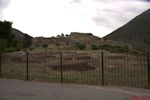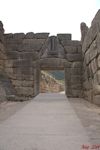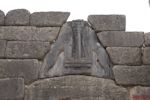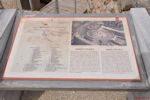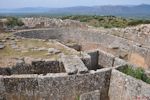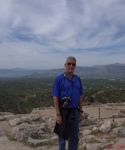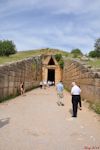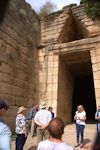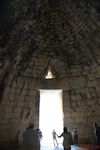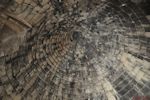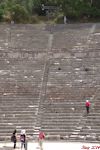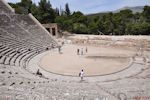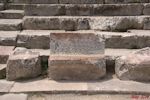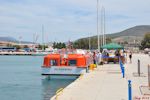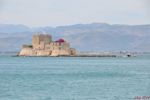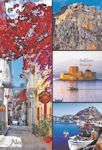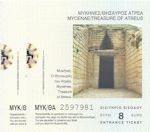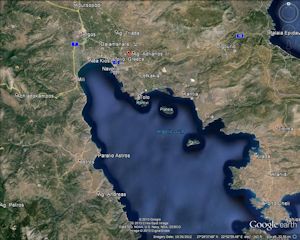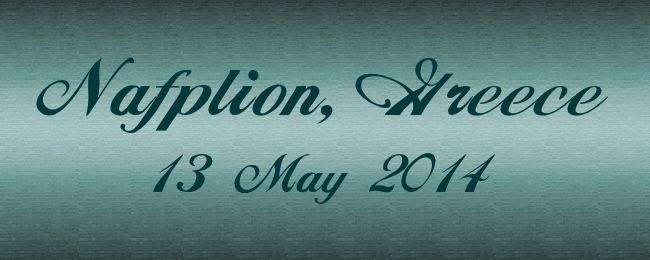
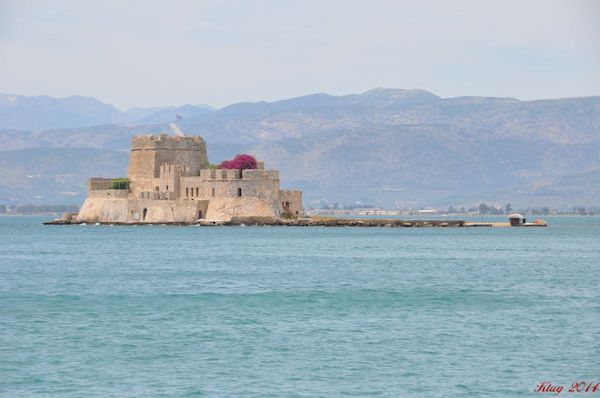
Photo by R Klug
Links to Port Pages
Nafplion, Greece
We arrived in the waters of Nafplion and anchored outside the harbor around 7 am. After our breakfast we joined our tour and tendered ashore. As you come into the port you pass by Bourtzi Castle on an island in the harbor. It was interesting to learn that the castle is a Venetian constructed fortification that became a site for the execution of prisoners, and eventually a boutique hotel, and now a tourist site. As we got closer in we could see the Five Brothers fortress and the Palamidi Castle on the hill above the town. The fortess looked like an interesting place to explore, but a very long climb up. We thought we might have time after the tour, but not this trip! Off the tender and onto a bus to drive through the Greek countryside towards Mycenae.
Mycenae lies on a hill overlooking a large valley. A very strategically located position. The Myceneans lived in the 16th to 12th century BC and spread from Greece throughout the Mediterranean basin. The acropolis site housed the royal house and their people.
Walking up the hill you enter through the Lion Gate. Once inside the gate and to the right on the edge of the hill is the Grave Circle which contained royal tombs. The gold funeral masks found here and other pieces are in the National Archaeological Museum in Athens. We saw many of the pieces, including the golden Mask of Agamemnon found by Heinrich Schliemann in 1876, on our cruise tour in 2012. After climbing to the top of the hill where the palace resided we could see the full view of the valley.
Our next stop was just down the road to the Treasury of Atreus. We did not know what we were going to see. Walking in to the Tomb of Agamemnon as it is also called, in a hill and then through a large stone lined entry we were in a round dark space. Once our eyes adjusted you could see that the inside construction resmbles a beehive. It is called a tholos tomb and required very precise placement of the stones. The largest circumference at the base and slowly decreasing as the walls went up. Our guide told us that it was actually constructed from inside and then up. When complete the workers left through the top and the entire tomb was covered over with dirt. The size of the stones are incredibly large, for example the lintel stone across the doorway weighs 120 tons.
Our last site to visit was the Theater of Epidaurus. The Sanctuary of Asklepios located near a spring was considered the center of healing in ancient times. The theater was constructed to provide entertainment and instruction. The acoustics are incredible. Even though the theater seats 15,000 epople, a soft word spoken at the center of the stage area can be heard in every seat. Of course, the guides all demonstrated this for the groups visiting.
After a stroll around the town area, we returned to the ship mid afternoon and grabbed a pizza on the pool deck and relaxed until dinner. The pizzas in the Pool Bar Grill are quite good. Different than our American styled pizzas as they are lightly sauced and topped with a variety suchas artichokes, parma ham - a while new flavor profile! Dinner was just us and very enjoyable in the Restaurant. Later on we met up with some of the other cruisers in the lounge for the rest of the evening. We stayed up a little later as our arrival into Katakolon would be around noon. A chance to sleep later than 6 am!
 |
|
Arriving in Nafplion, Greece |
Bourtzi Castle - a fortress, then a execution site, then a hotel! |
Hotel Grande Bretagne....in Nafplion! |
Mycenae acropolis |
Lion's Gate - entry to Mycenae acropolis |
Up close view of the capstone |
Sign describing the Grave Circle |
Grave Circle A - royal tombs |
Randy on the Mycenae acropolis |
Panorama - View from Mycenae |
Treasury of Atreus |
aka Tomb of Agamemnon |
Inside Treasury of Atreus |
Roof inside |
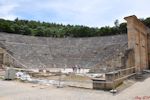 |
|
Epidaurus Sign |
Approaching the theater |
View of the theater |
Theater Seat View |
Panorama |
Theater seat - front row! |
Tender back to the Silver Wind |
Bourtzi in the afternoon |
Nafplion Postcard |
Ticket for the Treasury of Atreus |
![]()
Pre-cruise posts
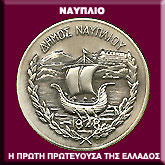 |
Updated: 25 January 2014
Nafplio (Modern Greek: Ναύπλιο, Nafplio) is a seaport town in the Peloponnese in Greece that has expanded up the hillsides near the north end of the Argolic Gulf. The town was the capital of the First Hellenic Republic, from the start of the Greek Revolution in 1821 until 1834. Nafplio is now the capital of the regional unit of Argolis (From Wikipedia)
From Silversea website: Oraia (beautiful) is the word Greeks use to describe Nafplion. The town's old section, on a peninsula jutting into the gulf of Argos, mixes Greek, Venetian, and Turkish architecture; narrow streets, often just broad flights of stone stairs, climb the slopes beneath the walls of Acronafplia. Tree-shaded plazas surround neoclassic buildings. The Palamidi fortress-an elegant display of Venetian might from the early 1700s-guards the town. Nafplion deserves at least a leisurely day of your undivided attention, and you may want to spend several days or a week here and use the city as the base from which to explore the many surrounding ancient sights.
A full exploration of this lovely town takes an entire day; a quick tour, with some omissions, could be done in three hours. Although a step-by-step itinerary can lead you to all the main sights, you can get a good sample of Nafplion just by following your nose through its winding streets and charming squares. Around Syntagma (Constitution) Square are some of Nafplion's top sights, including the Peloponnesian Folklore Foundation Museum, St. Spyridon Chruch, and the Archaeological Museum. The most picturesque avenue is Vasileos Konstantinou; the more-commercial Amalias is lined with shops. Westward you'll find the Church of the Virgin Mary's Birth, an elaborate post-Byzantine structure. Continuing north, you come to quayside and Philhellenes Square and St. Nicholas Church.
![]()
What We Plan to See: Update 25 January 2014
We scheduled the excursion to Mycenae! Incredible that we are getting to actually visit. Look at the description below from the Silversea website!
Theatre of Epidaurus & Mycenae, May 13 2014 - 4.5 Hours
Explore a pair of the most notable and historic structures in Nauplia during this memorable, half-day excursion to the ancient Theatre of Epidaurus, and a visit to Mycenae.
Epidaurus Depart the pier for the scenic, approximate 45-minute drive to Epidaurus. Situated on the cool slopes of a beautiful and wooded valley, Epidaurus was known throughout the Hellenic world for its unique medical facilities and healing treatments. The city was filled with curative spas and baths, and only priests had access to certain secret rites.
Theatre of Epidaurus Most of the ruins of Epidaurus have been reduced to their foundations, with the exception of the astonishing theatre. Still used for special performances, the Theatre of Epidaurus is in an admirable state of preservation. Built into the ground rather than above it, the theatre is renowned for its fantastic acoustics, which are heard during your visit.
Mycenae Next, re-board your coach and drive to the famous citadel of Mycenae via the Argos Plain. High above the confluence of two boulder-strewn ravines, Mycenae is entered by way of the Lion Gate, Europe's oldest piece of monumental statuary. Explore the Royal Palace, the shaft graves and the remains of the city walls, then attend an archaeological briefing within the Treasury of Artreus.
After a refreshment stop, commence the approximate 40-minute return drive to the pier.

Photo from Wikipedia
![]()
Seems that Nafplion is close to ancient Mycenae and Epidaurus. One of the ship tours includes a trip to Epidaurus which is described as: "Situated on the cool slopes of a beautiful and wooded valley, Epidaurus was known throughout the Hellenic world for its unique medical facilities and healing treatments. The city was filled with curative spas and baths, and only priests had access to certain secret rites." Sounds tempting to see!
Mycenae is an archaeological site on the UNESCO World Heritage Site list. It is believed that Mycenae was settled close to 2000 BC by Indo-Euopeans who practiced farming and herding. In the second millennium BC, Mycenae was one of the major centres of Greek civilization, a military stronghold which dominated much of southern Greece. The period of Greek history from about 1600 BC to about 1100 BC is called Mycenaean in reference to Mycenae.
Visiting UNESCO World Heritage Sites is high on our list!
![]()


